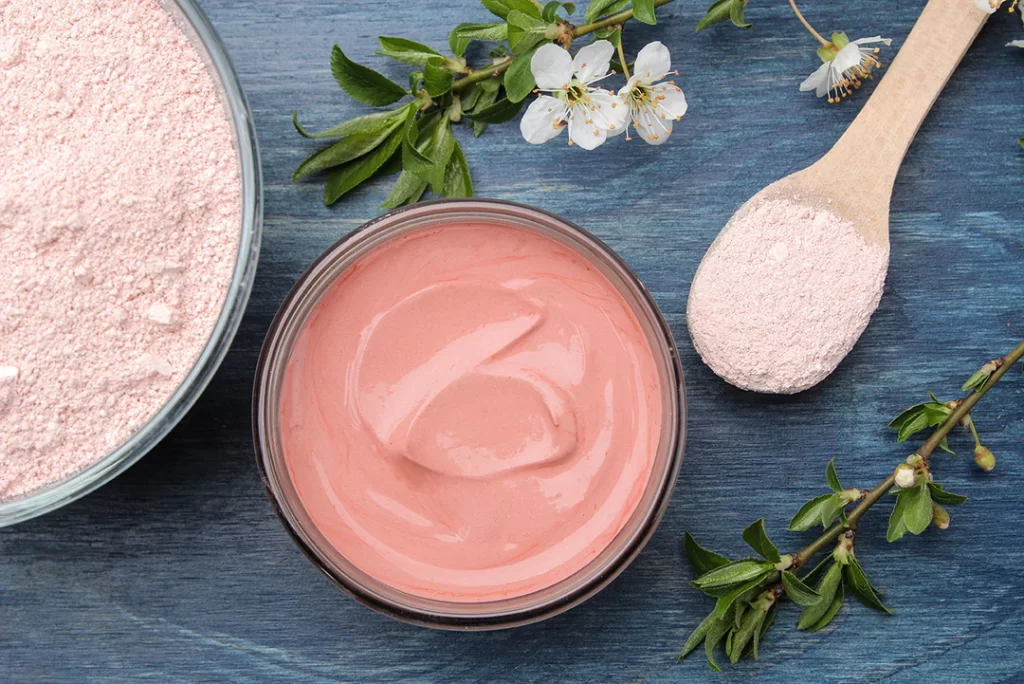
What’s the Difference Between Australian Pink Clay and French Pink Clay?
Clay masks, the one product an at-home spa evening would be nothing without! Using clay masks have been a pampering necessity which popularity dates back centuries, no really, centuries, back in 80 BC in Ancient Egypt, Queen Cleopatra would make a mask from white clay, milk, honey and olive oil. She would apply it all over her body in a bid to restore youth and radiance back into the skin. Fast forward to the modern century and our love for these masks hasn’t faulted, although now we tend to keep the application to our faces mostly.
In 2017 there was a surge in popularity for using clay masks, especially those made of pink clay. But there is more to these millennial favourite, Instagram worthy products. The benefits of pink clay are notably impressive, with every skin type being able to use them in complete comfort. Compared to other clay masks available, which tend to be very drying to sensitive skin, pink clay is a lot gentler and offers a more softening approach to clogged pores instead of drawing out the gunk like other masks. Pink clay can deeply cleanse the skin whilst leaving the natural oils of the skin uninterrupted.
What is Pink Clay?
Pink clay is a form of clay called Kaolin. Kaolin is usually found white, it takes on its pink hue depending on the percentage of iron oxide, the higher the level, the darker the kaolin clay, you will also find the clay becomes more absorbent too. Kaolin clay comes in various shades from red to white, red is great for oily skin types and white can be found mixed into several mask formulas for calming benefits. Pink is in the middle and provides a deep, pore cleansing properties whilst keeping the skin balanced and comfortable.
Skincare Benefits of Pink Clay
Pink clay is perfect to use on every skin type, particularly sensitive and dry. Enriched in minerals it can help to restore and replenish the skin by locking in moisture and draw out impurities whilst lightly exfoliating the skin to reveal a glowing complexion due to its slightly grainy texture.
For dry and sensitive skin types pink clay stops any irritation and inflammation whilst promoting a healthy cell turn over, which results in dry skins concerns such as dry flaky patches on the skin and look visibly brighter and smooth in appearance. Another reason pink clay is great for drier skin types is to do with the that the fact the clay doesn’t remove skin’s natural oils which keeps it balanced and comfortable.
Dehydrated skins will also notice how the skin feels more plumped and glowing with a helping hand from pink clay to stay hydrated, which can seem like a tricky task in colder temperatures. Luckily pink clay can protect the outer layer of skin from environmental aggressors, such as the weather and pollution.
Oily skins will experience a completely different selection of results when using pink clay. Don’t be fooled by the gentle approach of this clay on sensitive skin, it is indeed gentle, but powerful. Congested, blemish-prone skin will find pores are minimised, blackheads and spots are reduced and no signs of aggravation to cause any further breakouts.
Toxic air and pollution are at its highest levels since 2010 and so using a pink clay mask at least once a week will keep your skin at the healthiest it can be. Which will explain why the number of us reaching for a detoxifying mask has doubled. We have all experienced blackheads, spots or enlarged pores at some point and combating them is easily done with a 10-minute clay mask with its intense, deep cleansing that will rid you and your pores of grime, dirt, oil and even any leftover makeup that you missed with your cleanser! Once all that guck has gone you will notice smoother texture to your face, impurities lifted away and skin that is full of vitality.
A lot of the time acne and spot fighting masks and treatments are too harsh for the skin, and by achieving the “squeaky clean” feeling that is hugely desired, the skin is stripped of every drop of oil. This will result in the skin compensating for this and excess oil will be produced which in time leads to, yep you guessed it, spots and blemishes. By opting for a more gentle, but powerful approach, your skin’s natural barrier, pH levels and sebum production are left undisturbed and at its healthiest state.
As the title of this article may suggest there are different types of pink clay available. It is throughout this next section I will take the time to explain the difference in between Australian and French pink clay.
What’s the Difference?
Well, as the name suggests, both clays are harvested in different areas. Geographically this will mean they contain different minerals which could have slightly different effects on the skin.
French Pink Clay
The minerals found in pink clay are iron, illite, montmorillonite and calcite.
Illite is hugely beneficial for acne-prone skin for its ability to help decongested pores to become clear. It also stimulates the blood circulation resulting in the skin taking on a more toned with a younger complexion.
Montmorillonite is super absorbent and gently rids the skin of any excess oil without stripping it entirely.
Finally, there is calcite which is a crystal and is said to be great for purifying your energy, which to me sounds like just the sort of ingredient to have in a pampering clay mask. It draws out toxins, gently exfoliates the skin removing dead skin cells which make the skin appear dull. Blood circulation is encouraged and the skin is rejuvenated.
Harvested from the south of France, French pink clay has been used exclusive in spas in pampering, luxurious treatments for a great number of years, which will explain why at-home skin care products usually contain Australian pink clay more often, but with more brands opting for French, its popularity has started to build up some momentum.
Australian Pink Clay
Australian pink clay contains a completely different set of minerals, silica, magnesium, selenium and zinc.
Silicia is a natural anti-inflammatory substance that locks in moisture, which explains why pink clay is great to use for dry and eczema-prone skin types. Magnesium helps the skin to retain it’s natural fatty acids, perfect for giving your face that youthful, plumped appearance. Selenium is a great antioxidant that neutralises any harmful free radicals from damaging the skin’s natural barrier. Finally, zinc is wonderfully healing for the skin and any impurities are treated and made less visible, which is also makes pink clay a great skin care treatment for more mature skin.
Harvested from certain areas of Australia, this clay is packed with botanical extracts and minerals all working together to refine pores, detoxify pollution ridden skin and remove impurities. Due to the purity of the clay, it is soft but strong at battling against oils and shine.
Pink clay, French or Australian is packed with the minerals, free-radical fighting extracts that mean our skin can receive the best treatment. With the number of aggressors, we face day to day applying this millennial pink product will give you that helping hand in restoring your skin to its healthiest state with the added luxurious, pamper factor!
Don’t miss out on more skincare tips and expert advice over on our YouTube channel! Come and find us on The Green Sofa by hitting the subscribe button, you won’t regret it!


